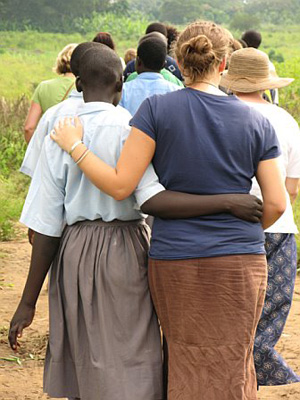I dusted off another of M. Scott Peck’s books this week to continue pursuing the theme of spiritual wellness. It’s called The Different Drum: Community Making and Peace.
Peck defines spiritual healing as the process of becoming “whole” or “holy.” In part, it is a call to individuate – to take responsibility for our lives and actions, to deal with others in integrity, and to make full use of our gifts and talents. Yet we are social creatures who need one another to survive. So “wholeness” also carries an expectation of living harmoniously in community and serving the common good. In fact, Peck argues that we cannot fully become ourselves without sharing the commonality of the human experience with others – e.g., our strengths, weaknesses, triumphs, failures, our self-sufficiency, incompleteness, etc.
 A spiritually enriching community isn’t just any old collective of people. According to Peck, it has very specific characteristics.
A spiritually enriching community isn’t just any old collective of people. According to Peck, it has very specific characteristics.
True community is, and must be, inclusive. It is always reaching out to extend itself and accepts individual and cultural diversity. To that end, the members must be willing to empty themselves of bias, prejudice, and expectations to make room for the other. They must be willing to co-exist in peace, surrendering themselves to the shared journey.
True community is realistic. It encourages many different viewpoints; it does not force conformity or smooth over its rough edges. It doesn’t expect easy answers to challenging questions or circumstances.
True community is contemplative. It is attentive to its health and growth. It acknowledges its fallibility and takes action to affect remediation. It is also keenly aware of the world outside, the world within, and the relationship between the two.
True community creates safety. It creates the space for members to explore their vulnerabilities and brokenness. It provides the breathing room for genuine healing to occur. It is accepting of one another’s limitations. And it supports members as they experiment with new kinds of behavior.
In true community, there are no sides. Alliances interfere with the group’s functioning. When conflict arises, a core of mutual respect and concern governs resolution. (I call it “disagreeing without becoming disagreeable.”) The members are committed to struggling together, not against each other.
True community decentralizes authority. Ideally, decisions are reached by consensus. Leadership flows freely among different individuals as the need arises. In fact, the so-called “natural leaders” refuse to take charge and tell people what to do. They want to avoid creating unhealthy dependencies.
Community-building takes time, intentional effort, and commitment. It takes time to empty ourselves of all the prejudices that impede our ability to be attentive and compassionate listeners. It takes conscious effort to communicate effectively while resisting the temptation to “fix” everyone. Rather, we’re called to be present to their experience while fostering individual and collective learning. It also takes effort to establish mutually agreeable “rules” and governance. Finally, it takes a commitment to hang in there through thick and thin, even when things get chaotic.
Peck warns against the formation of “pseudocommunity.” It’s a place characterized by forced politeness and a pressure to conform. In such communities, niceness crushes individuality, intimacy, and honesty. It fosters a quick retreat to organization as a vehicle for minimizing chaos and uncertainty. It is akin to building a house on a foundation made of sand. It won’t withstand stress and strain.
Community is always something more than the sum of the parts. It is never painless. It does not avoid conflict but rather reconciles it. In so doing, community lowers walls and creates pathways for growth and understanding. It exists for the purpose of inculcating love and harmony among us.
We are ultimately interdependent. Why not find ways to live together in peace?